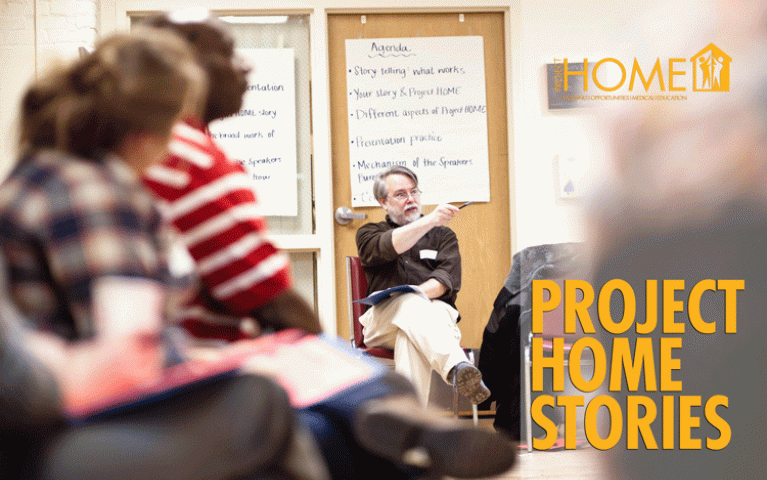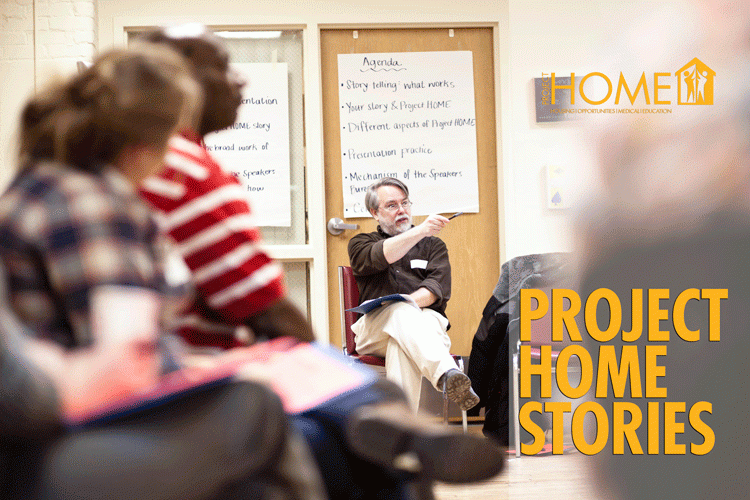A Journey of Understanding | Part One

Kim Covello is a retired attorney, commercial model, and mom of three . In this posting, the first of two parts, she recounts her volunteer experiences, including going on the street with outreach worker Sam Santiago. Kim continues the Journey…
I started a journey … seeking to understand the homeless. I started this journey as a volunteer for Project HOME, in January 2010.
Project HOME, a Philly organization started by Sister Mary Scullion over 20 years ago, seeks to alleviate homelessness by providing support services starting with street outreach and then continuing with supportive housing and other services needed by at-risk men and women. My first experience at Project H.O.M.E. was volunteering for breakfast duty at the Women’s Respite, a temporary winter shelter for women living on the streets, which was open from January to April 2010.
By the time the respite had to close in April, Project HOME was able to place many of the women in supportive housing and provide those remaining with some form of support services. So the wrap-up party in April was a happy event, with many of the women returning to the shelter to celebrate their new status. I still have the hand-decorated and written “Thank you” note from the women that I met and grew to know there. My journey continued … In May of 2010, I shadowed Sam Santiago, one of the outreach workers for Project HOME.
Project HOME’s Outreach Coordination Center (OCC) sends outreach teams to canvass the streets of Center City and the surrounding areas twenty-four hours a day, seven days a week, to connect homeless individuals with available support services like shelter, medical care, substance-abuse treatment, and mental health services. Sam Santiago knows the streets of Philadelphia, having been with the Philly police department for four years and then a private detective for seven years after that. And after eleven years with the OCC, most of our city’s homeless know Sam. I pepper Sam, a tall, machismo man with a heart of gold that he tries (unsuccessfully) to hide, with questions about his life’s work.
Sam’s work, I find as the day progresses, is a long, slow process of building trust; engaging people living on the street, getting to know them, learning what THEIR story is, what will help THEM get off the street. As Sam puts it, “It takes time; you have to give them time to trust you.”
My naïveté is apparent right from the start of this day when I ask Sam, “Why don’t they come in? Why don’t they take advantage of the services offered?” Sam quickly educates me about the men and women in the throes of addiction, who in many cases also suffer from debilitating mental illness. It hits me that making any rational, healthy decisions when living daily with these afflictions is extremely difficult. We begin on Market Street. Sam introduces me to Lisa (names have been changed) who is not homeless anymore but spends her days on the street, just as she used to.
Sam looks her directly in the eye and immediately engages her in conversation. “Hey, Lisa, how are you today? You’re still at your place?” Lisa’s clear blue eyes defy the rest of her appearance as she makes casual conversation about the weather. Sam acknowledges that Lisa, a 50-something white lady, “just can’t get the lipstick right.” Her candy-red lipstick is drawn in a thick line around her mouth, touching just about everything but her lips. Sam explains that Lisa has been in supportive housing for a while, but returns to Market Street every day with her bags and just hangs out. Old habits die hard. But Lisa is one of the success stories, having access to the medications that quiet the demons in her head and keep her from sleeping on the streets. Mr. Henry, whom we encounter further down the street, is not so lucky. Mr. Henry is a tall, handsome, elderly-looking man with dapper but threadbare clothes. He is lovely. I imagine old Mr. Henry as an elegantly-dressed maître’d at a fancy hotel restaurant.
But reality slaps me when I notice his dirty wing-tipped shoes and the shaking tin cup in his left hand. Mr. Henry and Sam talk for awhile; Mr. Henry gives Sam his birth date and Sam notes the information in his trusted pocket rolodex. We move on… Our next stop is Rittenhouse Square, a beautiful park in the toniest part of town. One of the hotels on the square lets us park in front. The bellman and Sam exchange greetings. In the park, Sam talks with Donny, a hippie in his 60s who never left that era and who’s so high, he thinks he’s still there. And then we talk with Brittany, a tall, lanky 16-year-old black girl who knows Sam, and openly answers him when he asks, “Why aren’t you in school?” Sam tries to get more information but she’s not talking today.
Sam believes she’s not homeless because she always has a different, clean set of clothes on every time he sees her. Brittany says to me “Sam really cares, you can tell.” Sam explains that Donny and his friends live in an “abandon-minium,” an abandoned building that they call “home.” Donny believes the abandon-minium is preferable to sleeping in the park. Most people don’t know that thirty to forty people sleep in Rittenhouse Square every night. The police wake them all up at 5:30 in the morning and force them to move on.
We walk over to three men sharing a bench, “Jimmy the Gun,” Tony, and Greg. Sam greets Jimmy, a short, 50-plus white man, LOUDLY: “Jimmy, the Man, the Myth, the Legend!” Jimmy laughs and says, “How about I knock your a_ _ out?” and then tells me, “I fought Joe Frazier!” Jimmy then says to me, “[Sam] loves me; I can tell.” Greg tells us he’s been drunk “all day” and Sam reminds him that it’s only 9 o’clock in the morning. They show us their drink – dollar store mouthwash, 29.6 percent alcohol.
Greg tells Sam he wants to go to detox; he’s ready. I’m practically gleeful but Sam calmly makes some phone calls and then escorts Greg into his car. Sam and I take Greg to 8th and Girard, the detox center. When we get there, Greg needs help getting out of the car. Greg hesitates in front of the door. I’m ready to push him through that door. I think, “This is great! We’re so close, just give him a nudge!” But Sam does just the opposite - he puts his hands up and says, “What do you want to do? You want to go in? Or go back to the park…?” I was ready to elbow Sam in the gut but instead I look at Greg and pray,…Greg says, “Go in.”
My lasting memory is Greg reluctantly letting go of my hand when we had to leave him in the detox center. In the car, Sam tells me that we can’t push anyone into recovery; it never works. They must make the decision themselves and take ownership of their actions. “Better chance of success,” he says.
